Top Investment Mistakes to Avoid in 2025

7 Critical Investment Mistakes You Need to Avoid in 2025
"There are no mistakes, only happy accidents," Bob Ross once said. While this might be true for painting, the same philosophy doesn't quite apply to investing. The financial decisions we make today can have lasting impacts on our future wealth. While it's natural to make mistakes along your investment journey, learning from them is what separates successful investors from the rest.
In this comprehensive guide, we'll explore seven common investment mistakes that could be holding back your portfolio's potential. Whether you're a seasoned investor or just starting out, understanding these pitfalls can help you make more informed decisions.
The Alpha Chase: When Higher Returns Cloud Your Judgment
One of the most seductive traps in investing is the relentless pursuit of alpha – the excess return of an investment relative to its benchmark. It's tempting to allocate most of your capital to assets showing the highest returns, but this strategy often backfires.
Consider this: Small-cap stocks have recently delivered impressive returns exceeding 20%, making them appear irresistible to retail investors. However, this is where understanding beta (market risk) becomes crucial. Let's break it down:
Imagine two stocks:
Stock A: Returns ₹5,000 with a beta of 0.6
Stock B: Returns ₹5,000 with a beta of 0.8
While both offer identical returns, Stock B exposes you to 33% more market risk. This perfectly illustrates why chasing returns without considering risk can be dangerous.
The Leverage Trap: Borrowing to Invest
Taking loans to invest in the stock market is akin to playing with fire. While leverage can amplify gains, it can equally magnify losses. The pressure of regular loan payments can force you to make emotional decisions, especially during market downturns when you need to stay rational the most.
Key Warning Signs:
Using personal loans for stock investments
Maxing out credit cards for trading
Borrowing against existing investments to buy more
The Procrastinator's Penalty: The Cost of Delayed Investing
Young professionals often feel they deserve to enjoy their first salary after years of studying. While treating yourself isn't wrong, completely postponing investing can be costly.
Let's examine the stark reality of delayed investing:
Starting at age 25: Investing ₹15,000 monthly for 35 years could grow to ₹6 crores (at 12% returns)
Starting at age 35: The same monthly investment for 25 years might only reach ₹1.89 crores
The cost of waiting: A staggering ₹4.11 crores lost to procrastination
The Diversification Paradox: When More Isn't Better
While diversification is crucial, over-diversification can dilute returns without providing additional protection. Investing in 15 mutual funds doesn't make your portfolio 15 times safer – it might just make it 15 times more complicated.
Common Over-Diversification Mistakes:
Holding multiple funds with overlapping portfolios
Paying unnecessary management fees for similar exposures
Losing focus on high-conviction investments
The Safety Myth: Understanding Relative Risk
No investment is 100% safe – even traditional "safe havens" like Fixed Deposits carry risks. The key is understanding and managing these risks rather than trying to eliminate them entirely.
Recent history provides sobering examples:
2008 Financial Crisis: 52% market crash
2020 Covid Crash: 23% market decline
- Blue-chip stocks like Reliance and HDFC: Dropped 40%
The Information Trap: Avoiding Bad Investment Advice
In today's digital age, investment advice is abundant but not always reliable. Be particularly wary of:
Telegram groups promising "guaranteed returns"
Hot stock tips from unverified sources
Simplified market commentary that ignores fundamental analysis
Remember: If information is freely available to everyone, it's likely already priced into the market.
The Emotional Attachment: Learning When to Let Go
Perhaps the most challenging aspect of investing is knowing when to cut losses. Many investors fall into the trap of becoming emotionally attached to their investments, especially their first ones or those that previously performed well.
Implementing Stop-Loss Strategy:
Set clear exit points before investing
Review and adjust stop-loss levels periodically
Follow through with your strategy regardless of emotional attachment
The Path Forward
Success in investing isn't about avoiding all mistakes – it's about learning from them and developing a systematic approach to decision-making. Focus on:
Understanding both risk and return
Starting early and staying consistent
Maintaining emotional discipline
Building a well-researched, appropriately diversified portfolio
Remember, the goal isn't to achieve the highest possible returns, but rather to build sustainable wealth that aligns with your financial goals and risk tolerance.


















